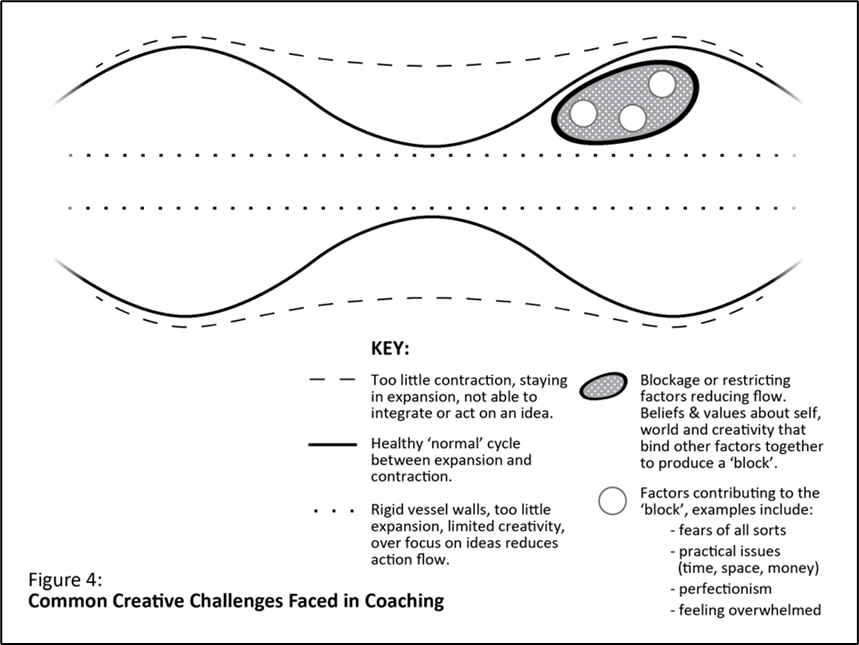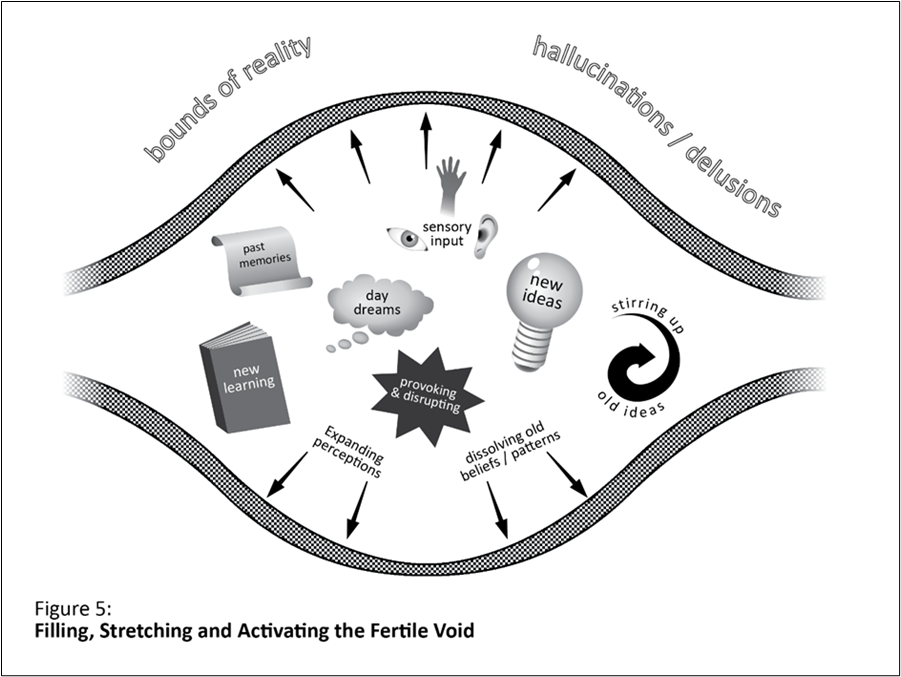I started to develop a model of creativity, mostly to explore how coaching may support creativity, but as it developed I found many other applications. I never gave it a name as such, but reckon this snappy title works: EIS (Expansion, integration, synthesis) a model of creative flow. You can learn about the origins of the model here in this video.
I currently have various challenges in relation to my creativity, so I reckon it’s time to walk my talk and see how my espoused creativity model could help these creative challenges and improve my flow.
This first diagram shows the most common challenges that affect creative flow. These include: “blocks” and the factors, both psychological and physical, that contribute to the block; over focus/rigidity and lack of flexibility; too much flexibility and lack of focus; lack of integrating ideas. If these concepts don’t make sense, do make sure you watch the video called “waving hands” The diagram below represents this model in its basic form:
Using this model to reflect, I can see unhelpful things impacting on my creative process:
· Blocks including my physical space – lack of study/writing space plus my studio being too small for the type of painting I want to do. Yes, there are lots of fears but they are always there. Yes, I am in overwhelm and don’t have enough time, but again, that feels like nothing new. My self-belief is another thing though. Although it is rather delicate, it has taken a real blow of late. The postponement of my solo show was a nail in the self-belief coffin in many ways. Self-belief is a complex issue but combined with my recent lack of flow, I have lost the focus that comes with a solo show, and it has hit me harder than it should.
· I think my vessel walls have been too rigid of late, or perhaps not stretched enough. I think the expansion needs to be fuller – there needs to be more in that pot, that space. A richer, more intense mix of things. When I think of the focus and immersion of past projects, I was putting a lot into my creativity pot – reading, researching, drawing, experimenting etc.
· I do know that my ideas feel under-developed. In this model it includes those contracting forces which involve integration of an idea. It feels like I am contracting too quickly and deciding on an output too quickly, rather than letting it develop.
· There are other problems in this phase too - it is not a healthy movement between expansion and contraction. I expand and put some stuff in the pot, then forget or get distracted or don’t have the time to contract properly or expand again to embrace the learning or add other things to the pot.
· There is also too much focus on output, on that point of action, on the production of work for sale. I spent 25 years saying I wasn’t interested in making work to sell and I somehow need to get back to that feeling. The expectations of the galleries and knowing what they can sell easily and would like more of, has definitely impacted on the overall vitality of my vessel and its walls. I keep thinking will this painting sell, can I find some people in this painting because apparently buyers like that, or can I make this painting more like Forest Wedding or Milk. It’s a not a killer, but it does affect things.
So what can I do ? This diagram illustrates some of the things I could consider:
Clearly I need to fill, stretch and activate my pot/void (feel free to giggle!). I need to agitate it and help it percolate. To do this I will:
- Stir up old ideas. This will include re-visiting my creativity model itself but also applying it. I reckon I also need to re-read the whole book and remind myself how good it is. It will also include revisiting “The Artist and Engineer” a joint project with a friend who has just passed away.
- Past memories – well I need to remember old ideas that I wrote down and revisit and take some of them forward, e.g. greenhouses, moonbows.
- Daydreams – and night dreams too. I need to find a way to draw those dreams and record them visually. I probably need to spend longer on them, use colour and keep going.
- New learning is needed, and I am thinking about new materials such as working on plaster/tempera and perhaps working on transparent, folded fabrics
- The dissolving of unhelpful patterns, habits and beliefs is always trickier. Not all beliefs that are unhelpful are untrue e.g. As a white, middle-age, middle-class woman. I am in an unpopular demographic Perhaps when I get older, that might change, but as history and culture tries to rebalance the historical over representation of middle-class, white people, I feel it’s a barrier for me. Also true is my general position in society – I don’t live in London, I don’t have helpful connections or a family within helpful social circles, I don’t have a wealthy patron, I don’t have an under-grad art education, that is accepted and enables entry. I wonder what might have happened if I had painted in the early 1990s and become a YBA? Different time, different place. Although these beliefs are “just” limiting beliefs, there is a lot of truth to them.
- There are some patterns of behaviour which I have more power to change e.g. patterns of practice, such as: I find myself not filling my palette properly and using grungy little bit of paint; I have too many paintings in my face at once which is ok if they are perhaps in the same ilk, but not if they are vastly different in topic and process; I need to sit with my paintings for longer but then be able to “strike while the iron is hot” and paint furiously, rather than let the energy dissipate (and write myself notes if I can strike, so I don’t keep forgetting stuff); I need more focussed and boundaried studio time and experiment with time limits – limited time helped me in the competition and I think it would help and help my memory problems; I need to draw more but seem to lack some discipline in – I’ll sign up to an actual drawing day or classes at the Bristol drawing school.
Gosh, that was a lot! It has helped and already things are starting to shift around internally. My inner coach wants me to make a list of “action points” which could include:
· Put a weekly drawing class in my diary (or structured drawing activity)
· Keep palette clearer and be conscious of trying to paint with dried up, muddy paint hahaha
· Experiment with new surfaces, e.g. plaster or thin fabric
· Re-visit old sketch and ideas that you half developed.
· Remember that my job is to create, be that painting, writing or other formats.
· Find a place where being white/middle-class/middle-aged is welcome or just say “fuck it”
You get the idea. I can probably find another 3 or 4 “action points” but I am already feeling a little overwhelmed. Just “actioning” these will take time and energy it’s enough for now.
I hope this has been interesting and you feel you can experiment with the model in regard to your own creative challenges. Do message me or comment with any thoughts and ideas.
Jen




Yours is by far the most interesting 'Newsletter' out there.
That was very moving to read, Jen. I identify with several elements, so it is both reassuring and inspiring